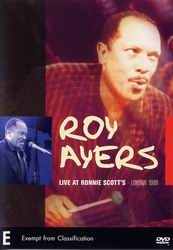Roy Ayers-Live at Ronnie Scott's (1988) (NTSC) |
|
Roy Ayers-Live at Ronnie Scott's (1988) (NTSC) |
|


|
| BUY IT |
| General | Extras | ||
| Category | Music |
Main Menu Audio & Animation Featurette-Review Audio Commentary |
|
| Rating |

|
||
| Year Of Production | 1988 | ||
| Running Time | 52:57 (Case: 55) | ||
| RSDL / Flipper | No/No | Cast & Crew | |
| Start Up | Menu | ||
| Region Coding | 4 | Directed By | Matt McConaghy |
|
Studio
Distributor |
 Warner Vision |
Starring |
Roy Ayers Dwight Gassaway Zachary Breaux Errol Louis Ben Peronsky |
| Case | Click | ||
| RPI | $34.95 | Music | Roy Ayers |
| Video (NTSC) | Audio | ||
| Pan & Scan/Full Frame | Full Frame |
English Dolby Digital 2.0 (224Kb/s) English Audio Commentary Dolby Digital 2.0 (224Kb/s) English Dolby Digital 5.1 (448Kb/s) |
|
| Widescreen Aspect Ratio | None | ||
| 16x9 Enhancement | No | ||
| Video Format | 480i (NTSC) | ||
| Original Aspect Ratio | 1.33:1 | Miscellaneous | |
| Jacket Pictures | No | ||
| Subtitles | None | Smoking | No |
| Annoying Product Placement | No | ||
| Action In or After Credits | Yes, the credits appear over the end of the final song. | ||
Ayers and his band are all amazing musicians, and the tracks they present here are at once easy to get into, and very impressive musically. The man certainly can play his vibes. None of the other names present in the band were recognisable to me, but Zachary Breaux sets the tone in the first few songs with some great guitar work, and later on percussionist Dwight Gassaway proves that he is virtually on-par with Ayers when it comes to the vibes. It is, in fact, the Battle of the Vibes that is easily the most impressive track on this disc. As Ayers and Gassaway engage in a faux "cutting contest" (a jazz tradition where musicians challenge other musicians to out-play and out-skill them live on stage), their abilities come to the fore, and it is hard not to be impressed by the obvious musicianship at work.
Visually, it is fairly obvious that this concert was filmed during the '80s - one shot of the crowd is generally enough to prove that. The concert itself is a relatively static affair as the band barely fit on the stage, leaving little room for moving around. Even so, Ayers is able to warm the audience to him (although he does start quite badly) with good use of humour between songs. Additionally, the relatively short length of the concert combined with judicious use of camera angles means that this show plays in a very similar manner to what it is - a club gig - and does not get the "small hall" feel that sometimes occurs with recorded concerts.
This disc will please any Roy Ayers fan (although the 50 minute running time is somewhat short), while those looking to explore jazz with a groove could do worse than to have a look. The music is good, the musicianship excellent, and the concert nicely intimate. Overall, this is an appealing package.
| 1. Spirit Of Doo Doo 2. I Wanna Touch You 3. Everybody Loves The Sunshine 4. Fast Money | 5. Battle Of The Vibes 6. Can't You See Me 7. Running Away 8. Don't Stop The Feeling |
The video transfer for Roy Ayers: Live At Ronnie Scott's is of a decidedly low quality, although given that it was probably shot for video release in the late '80s, this is not entirely unexpected.
Presented at 1.33:1 this transfer is not 16x9 enhanced. As it was shot in the late '80s and probably only intended for video release, 1.33:1 is almost certainly the original aspect ratio, although there is no technical information to confirm this. The composition of the shots would appear to confirm that 1.33:1 was how this show was put together.
For the most part, sharpness is simply passable, being good enough to make out the actions and instruments easily, but certainly a long way short of what DVD is capable of. There is also a fair amount of "grain" present. Although the opening shot from 0:00 to 0:16 is probably the worst, the rest of the show is constantly marred by background grain. Shadow detail is, in a word, bad. Anything that is not well lit disappears into a patchwork of murk, becoming very difficult to see. There is also a plethora of low level noise visible throughout the transfer, such as at 4:44, and 13:49-51. It really stands out and can be quite annoying.
The colours are not particularly good, being adversely affected by the stage lighting, and the low light levels for crowd shots. However, given the nature of the jazz club show, this is certainly not the greatest problem with the transfer.
Compression artefacts are restricted to a few instances of pixelization over the sequences with higher grain or low level noise. Strangely for what is a fairly soft transfer, there are a number of obvious instances of aliasing, most notably on the microphone stand from 30:12 to 30:21, and again from 41:31 to 41:45. Film artefacts are quite common, and while most are small, there are a few, such as the large white blob at 8:04, that are large and distracting.
There are no subtitles on this disc.
This is a single layered disc and as such is not interrupted by a layer change.
| Sharpness | |
| Shadow Detail | |
| Colour | |
| Grain/Pixelization | |
| Film-To-Video Artefacts | |
| Film Artefacts | |
| Overall |
There are three soundtracks present, being English audio tracks in both Dolby Digital 2.0 stereo (at 224 Kbps), and Dolby Digital 5.1 (at 448 Kbps), and an "audio commentary" track presented in Dolby Digital 2.0 stereo (at 224 Kbps).
The lyrics are generally clear and easy to understand at all times, while the instruments are well presented and easy to make out. The band is not overly large, consisting of at most five different instruments at one time, and all being quite different in sound, and this aids in the easy to separate soundscape. The mixing levels are well controlled, as the vocals never clash with the instruments, nor do the instruments overpower the vocals. The only real problem with the soundtrack is that during the middle of the performance in the quieter moments, there is a rather grating hiss/feedback noise that is obviously linked to the stage mikes, as it only occurs when the band members talk to the crowd. While it becomes inaudible as the volume increases, it is grating enough to be very annoying. The worst example is at the beginning of track 5 (Battle of the Vibes), and this is compounded by the fact that this track starts with around three minutes of dialogue.
Audio sync is spot on throughout the transfer, and is never a problem.
The surround channels are used well enough in the 5.1 mix, as excluding the ubiquitous placement of crowd noise to the surrounds, they are only used for a few instruments, such as certain percussion sounds, and do a good job of immersing the listener. They do have a habit of delivering a stereo reflection of the front channels at times, but this is normally at a low enough level as to not be noticeable. Separation across the front channels is not particularly good, and the centre channel largely lies dormant. The 2.0 mix seems to be identical to the 5.1 mix, excluding the presence of surrounds. A direct swap between the stereo and 5.1 soundtracks mid-song is hard to pick, and there are times where the 2.0 mix even has a slightly wider separation across the front channels, giving the impression of more "surround" than that delivered by the 5.1 soundtrack. Overall, I would rate the two as even, although the 5.1 track has the added benefit of localized crowd noise - always a bonus for concert discs.
The subwoofer is not worked too hard during this presentation. Neither the 5.1 nor the stereo track taxes the lower frequencies to an enormous extent, although the 5.1 track does seem to have slightly more bass. What there is is well defined and definitely adds to the presentation, and there will be some who prefer this "hands-off" approach to bass in music (especially the 5.1 track). Personally, I prefer slightly more use of my subwoofer.
| Dialogue | |
| Audio Sync | |
| Clicks/Pops/Dropouts | |
| Surround Channel Use | |
| Subwoofer | |
| Overall |
NOTE: To view non-R4 releases, your equipment needs to be multi-zone compatible and usually also NTSC compatible.
The video quality is not good, very much giving away its origins. This is a music DVD however...
The audio quality is good, presenting a very listenable concert that almost makes you forget about the video quality - almost.
The extras are few, and only of little interest. Still, it is nice to see extras of any sort on a disc such as this.
| Video | |
| Audio | |
| Extras | |
| Plot | |
| Overall |
| Review Equipment | |
| DVD | Pioneer DV-535, using Component output |
| Display | Loewe Xelos 5381ZW. Calibrated with Video Essentials. This display device is 16x9 capable. |
| Audio Decoder | Built in to amplifier/receiver. Calibrated with Video Essentials. |
| Amplification | Onkyo TX-DS787, THX Select |
| Speakers | All matching Vifa Drivers: centre 2x6.5" + 1" tweeter (d'appolito); fronts and rears 6.5" + 1" tweeter; centre rear 5" + 1" tweeter; sub 10" (150WRMS) |